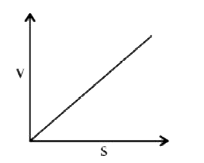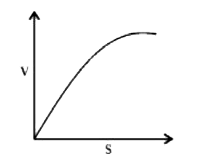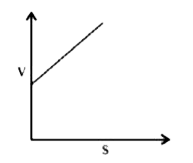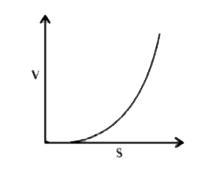A scooter starting from rest moves wilth as constant acceleration for a time △t1, then with a constant velocity for the next △t2 and finally with a constant deceleration for the next △t3 to come to rest. a 500N man sitting on the scooter behind the driver manages to stay at rest with respect to the scooter wilthout touching any other part. The force exerted by the seat on the man is
500 N throughout the journey
less than 500 N throughout the journey
more than 500 N throughtout the journey
>500Nfortime△1and△3and500Nfor△t2.
The correct Answer is:D
To find the force exerted by the seat on the man sitting on the scooter, we need to analyze the three phases of motion of the scooter: acceleration, constant velocity, and deceleration.
1. Understanding the Forces Acting on the Man:
- The man has a weight of 500 N, which acts downwards due to gravity.
- The normal force (N) exerted by the seat acts upwards.
2. Phase 1: Acceleration (Time Δt1):
- When the scooter accelerates, the man experiences a pseudo force acting in the opposite direction of the acceleration due to the non-inertial frame of reference.
- This pseudo force is equal to Fpseudo=m⋅a, where m is the mass of the man and a is the acceleration of the scooter.
- Since the man is at rest with respect to the scooter, the normal force must balance both the weight and the pseudo force:
N=mg+Fpseudo
- Therefore, the normal force N is greater than 500 N during this phase.
3. Phase 2: Constant Velocity (Time Δt2):
- When the scooter moves with constant velocity, there is no acceleration, and thus no pseudo force acting on the man.
- The only force acting on him is his weight, which is balanced by the normal force:
N=mg=500N
- Therefore, the normal force N is exactly 500 N during this phase.
4. Phase 3: Deceleration (Time Δt3):
- Similar to the acceleration phase, when the scooter decelerates, the man again experiences a pseudo force acting in the opposite direction of the deceleration.
- The normal force must again balance both the weight and the pseudo force:
N=mg+Fpseudo
- Thus, the normal force N is greater than 500 N during this phase as well.
Conclusion:
The force exerted by the seat on the man is:
- Greater than 500 N during the acceleration and deceleration phases.
- Equal to 500 N during the constant velocity phase.
Thus, the correct answer is:
Greater than 500 N for time Δt1 and Δt3, and 500 N for Δt2.
- The man has a weight of 500 N, which acts downwards due to gravity.
- The normal force (N) exerted by the seat acts upwards.
- When the scooter accelerates, the man experiences a pseudo force acting in the opposite direction of the acceleration due to the non-inertial frame of reference.
- This pseudo force is equal to Fpseudo=m⋅a, where m is the mass of the man and a is the acceleration of the scooter.
- Since the man is at rest with respect to the scooter, the normal force must balance both the weight and the pseudo force:
N=mg+Fpseudo
- Therefore, the normal force N is greater than 500 N during this phase.
- When the scooter moves with constant velocity, there is no acceleration, and thus no pseudo force acting on the man.
- The only force acting on him is his weight, which is balanced by the normal force:
N=mg=500N
- Therefore, the normal force N is exactly 500 N during this phase.
- Similar to the acceleration phase, when the scooter decelerates, the man again experiences a pseudo force acting in the opposite direction of the deceleration.
- The normal force must again balance both the weight and the pseudo force:
N=mg+Fpseudo
- Thus, the normal force N is greater than 500 N during this phase as well.
The force exerted by the seat on the man is:
- Greater than 500 N during the acceleration and deceleration phases.
- Equal to 500 N during the constant velocity phase.
Greater than 500 N for time Δt1 and Δt3, and 500 N for Δt2.
Topper's Solved these Questions
- FRICTIONBOOK - HC VERMACHAPTER - FRICTIONEXERCISE - Objective 2
5 Videos
- FRICTIONBOOK - HC VERMACHAPTER - FRICTIONEXERCISE - Exercises
31 Videos
- FRICTIONBOOK - HC VERMACHAPTER - FRICTIONEXERCISE - Short Answer
11 Videos
- FLUID MECHANICSBOOK - HC VERMACHAPTER - FLUID MECHANICSEXERCISE - Exercises
35 Videos
- GRAVITATIONBOOK - HC VERMACHAPTER - GRAVITATIONEXERCISE - Exercises
39 Videos
Similar Questions
A body starts from rest & moves with constant acceleration a1 for time t1 then it retards uniformly with a2, in time t2 and finally comes at rest. Find t1t2
View SolutionA car starts from rest and moves along the x-axis with constant acceleration 5ms−2 for 8 seconds. If it then continues with constant velocity, what distance will the car cover in 12 seconds since it started from the rest ?
View Solution
Knowledge Check
A scooter starting from rest moves wilth as constant acceleration for a time △t1, then with a constant velocity for the next △t2 and finally with a constant deceleration for the next △t3 to come to rest with resect to the scooter wilthout touching any other part. The force exerted by the seat on the man is
A500 N throughout the journeyBless than 500 N throughout the journey.Cmore than 500 N throughout the journey.D>500N for time Δt1andΔt3and500N for Δt2A scooter starting from rest moves wilth as constant acceleration for a time △t1, then with a constant velocity for the next △t2 and finally with a constant deceleration for the next △t3 to come to rest. a 500N man sitting on the scooter behind the driver manages to stay at rest with respect to the scooter wilthout touching any other part. The force exerted by the seat on the man is
A500 N throughout the journeyBless than 500 N throughout the journeyCmore than 500 N throughtout the journeyD>500Nfortime△1and△3and500Nfor△t2.A particle starts from rest and moves with constant acceleration. Then velocity displacement curve is:
A B
B C
C D
D
A car starts from rest and moves with constant acceleration. In first t seconds it covers distance x. Then distance covered by it in next t seconds will be:-
View SolutionA body starts from rest and moves with constant acceleration for t s. It travels a distance x1 in first half of time and x2 in next half of time, then
View SolutionA particle starts from rest with constant acceleration. The ratio of space-average velocity to the time average velocity is :-
View SolutionA car, starting from rest, has a constant acceleration for a time interval t1 during which it covers a distance In the next time interval the car has a constant retardation and comes to rest after covering a distance in time Which of the following relations is correct?
View SolutionA particle starts moving from rest under a constant acceleration. It travels a distance x in the first 10 sec and distance y in the next 10 sec, then
View Solution
